Successful Creativity, Innovation, and Design Thinking Essay
VerifiedAdded on 2022/09/16
|7
|2093
|23
Essay
AI Summary
This essay explores the critical role of employees in driving creativity, innovation, and design thinking within organizations. It argues that employees are the primary drivers of creative activities and innovation, emphasizing their impact on achieving business objectives and improving company efficiency. The essay defines creativity, innovation, and design thinking, highlighting their interdependence and the necessity of human resource management. It uses examples like Tesla and Google to illustrate how employee contributions, including idea sharing and collaborative environments, lead to successful innovation and competitive advantage. The essay also references models like the componential model and the Interactionist Perspective of Organizational Creativity, underscoring the influence of work environments and team dynamics on fostering creativity. It concludes that successful innovation, creativity, and design thinking are inextricably linked to the efforts and collaboration of every employee within an organization, emphasizing the importance of human resource management in driving business success.
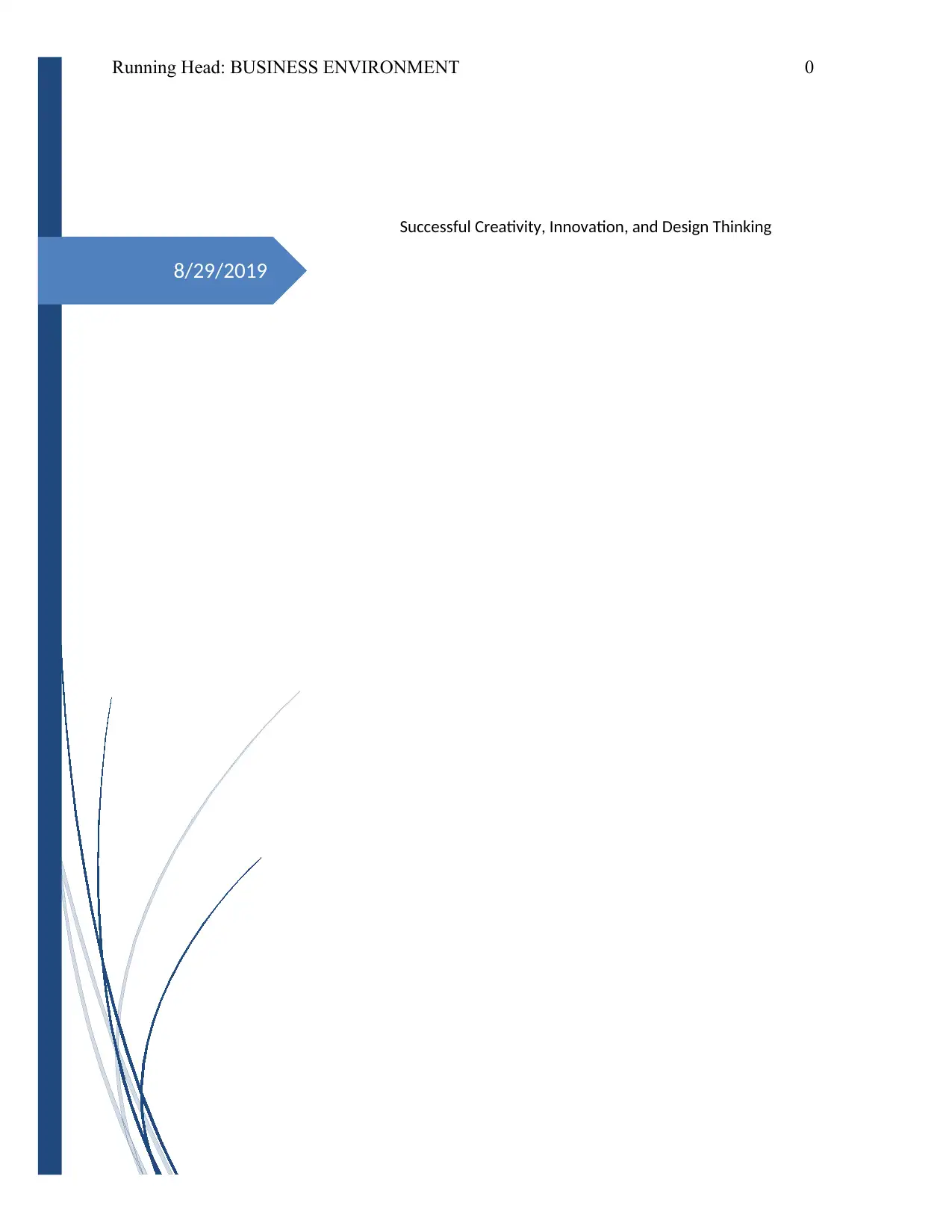
8/29/2019
Running Head: BUSINESS ENVIRONMENT 0
Successful Creativity, Innovation, and Design Thinking
Running Head: BUSINESS ENVIRONMENT 0
Successful Creativity, Innovation, and Design Thinking
Secure Best Marks with AI Grader
Need help grading? Try our AI Grader for instant feedback on your assignments.
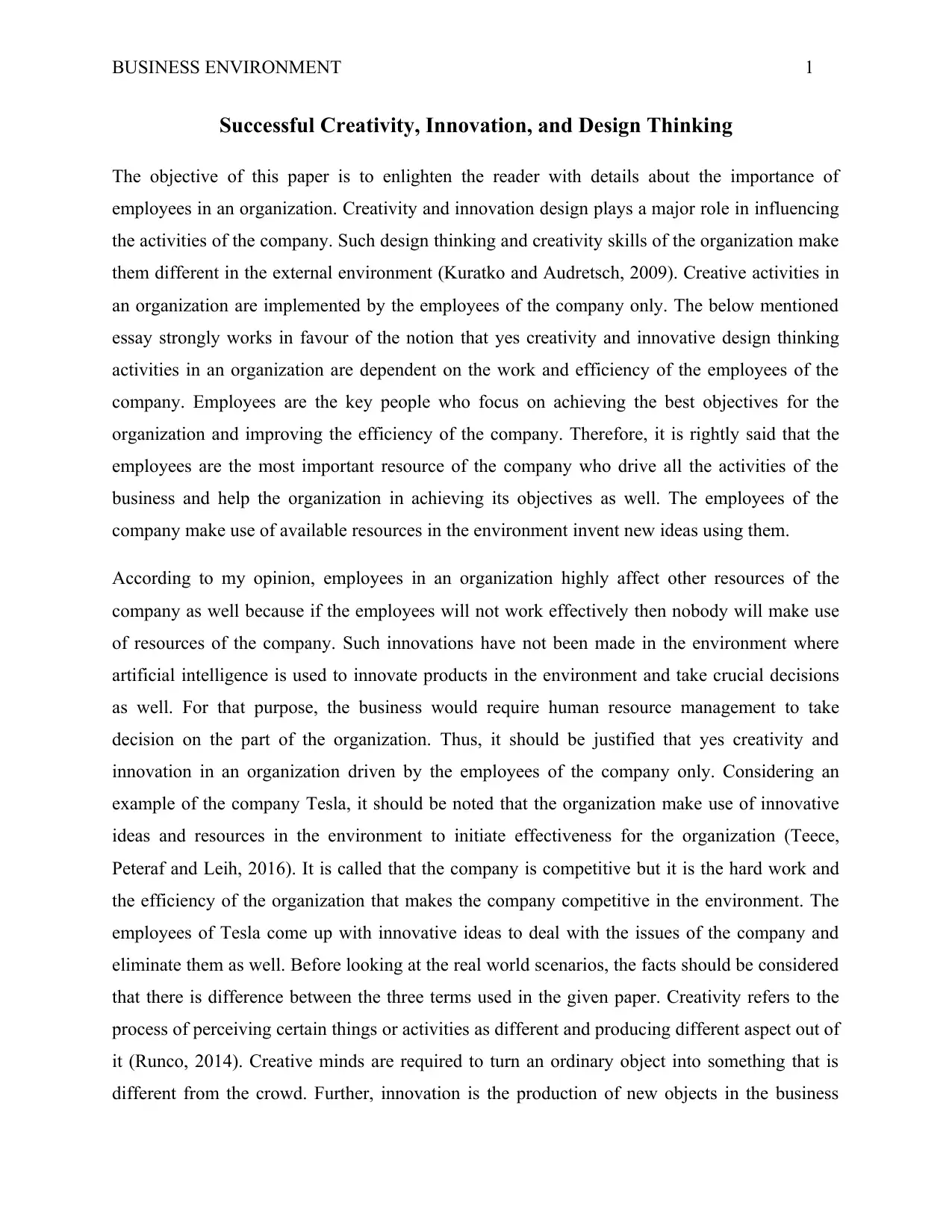
BUSINESS ENVIRONMENT 1
Successful Creativity, Innovation, and Design Thinking
The objective of this paper is to enlighten the reader with details about the importance of
employees in an organization. Creativity and innovation design plays a major role in influencing
the activities of the company. Such design thinking and creativity skills of the organization make
them different in the external environment (Kuratko and Audretsch, 2009). Creative activities in
an organization are implemented by the employees of the company only. The below mentioned
essay strongly works in favour of the notion that yes creativity and innovative design thinking
activities in an organization are dependent on the work and efficiency of the employees of the
company. Employees are the key people who focus on achieving the best objectives for the
organization and improving the efficiency of the company. Therefore, it is rightly said that the
employees are the most important resource of the company who drive all the activities of the
business and help the organization in achieving its objectives as well. The employees of the
company make use of available resources in the environment invent new ideas using them.
According to my opinion, employees in an organization highly affect other resources of the
company as well because if the employees will not work effectively then nobody will make use
of resources of the company. Such innovations have not been made in the environment where
artificial intelligence is used to innovate products in the environment and take crucial decisions
as well. For that purpose, the business would require human resource management to take
decision on the part of the organization. Thus, it should be justified that yes creativity and
innovation in an organization driven by the employees of the company only. Considering an
example of the company Tesla, it should be noted that the organization make use of innovative
ideas and resources in the environment to initiate effectiveness for the organization (Teece,
Peteraf and Leih, 2016). It is called that the company is competitive but it is the hard work and
the efficiency of the organization that makes the company competitive in the environment. The
employees of Tesla come up with innovative ideas to deal with the issues of the company and
eliminate them as well. Before looking at the real world scenarios, the facts should be considered
that there is difference between the three terms used in the given paper. Creativity refers to the
process of perceiving certain things or activities as different and producing different aspect out of
it (Runco, 2014). Creative minds are required to turn an ordinary object into something that is
different from the crowd. Further, innovation is the production of new objects in the business
Successful Creativity, Innovation, and Design Thinking
The objective of this paper is to enlighten the reader with details about the importance of
employees in an organization. Creativity and innovation design plays a major role in influencing
the activities of the company. Such design thinking and creativity skills of the organization make
them different in the external environment (Kuratko and Audretsch, 2009). Creative activities in
an organization are implemented by the employees of the company only. The below mentioned
essay strongly works in favour of the notion that yes creativity and innovative design thinking
activities in an organization are dependent on the work and efficiency of the employees of the
company. Employees are the key people who focus on achieving the best objectives for the
organization and improving the efficiency of the company. Therefore, it is rightly said that the
employees are the most important resource of the company who drive all the activities of the
business and help the organization in achieving its objectives as well. The employees of the
company make use of available resources in the environment invent new ideas using them.
According to my opinion, employees in an organization highly affect other resources of the
company as well because if the employees will not work effectively then nobody will make use
of resources of the company. Such innovations have not been made in the environment where
artificial intelligence is used to innovate products in the environment and take crucial decisions
as well. For that purpose, the business would require human resource management to take
decision on the part of the organization. Thus, it should be justified that yes creativity and
innovation in an organization driven by the employees of the company only. Considering an
example of the company Tesla, it should be noted that the organization make use of innovative
ideas and resources in the environment to initiate effectiveness for the organization (Teece,
Peteraf and Leih, 2016). It is called that the company is competitive but it is the hard work and
the efficiency of the organization that makes the company competitive in the environment. The
employees of Tesla come up with innovative ideas to deal with the issues of the company and
eliminate them as well. Before looking at the real world scenarios, the facts should be considered
that there is difference between the three terms used in the given paper. Creativity refers to the
process of perceiving certain things or activities as different and producing different aspect out of
it (Runco, 2014). Creative minds are required to turn an ordinary object into something that is
different from the crowd. Further, innovation is the production of new objects in the business
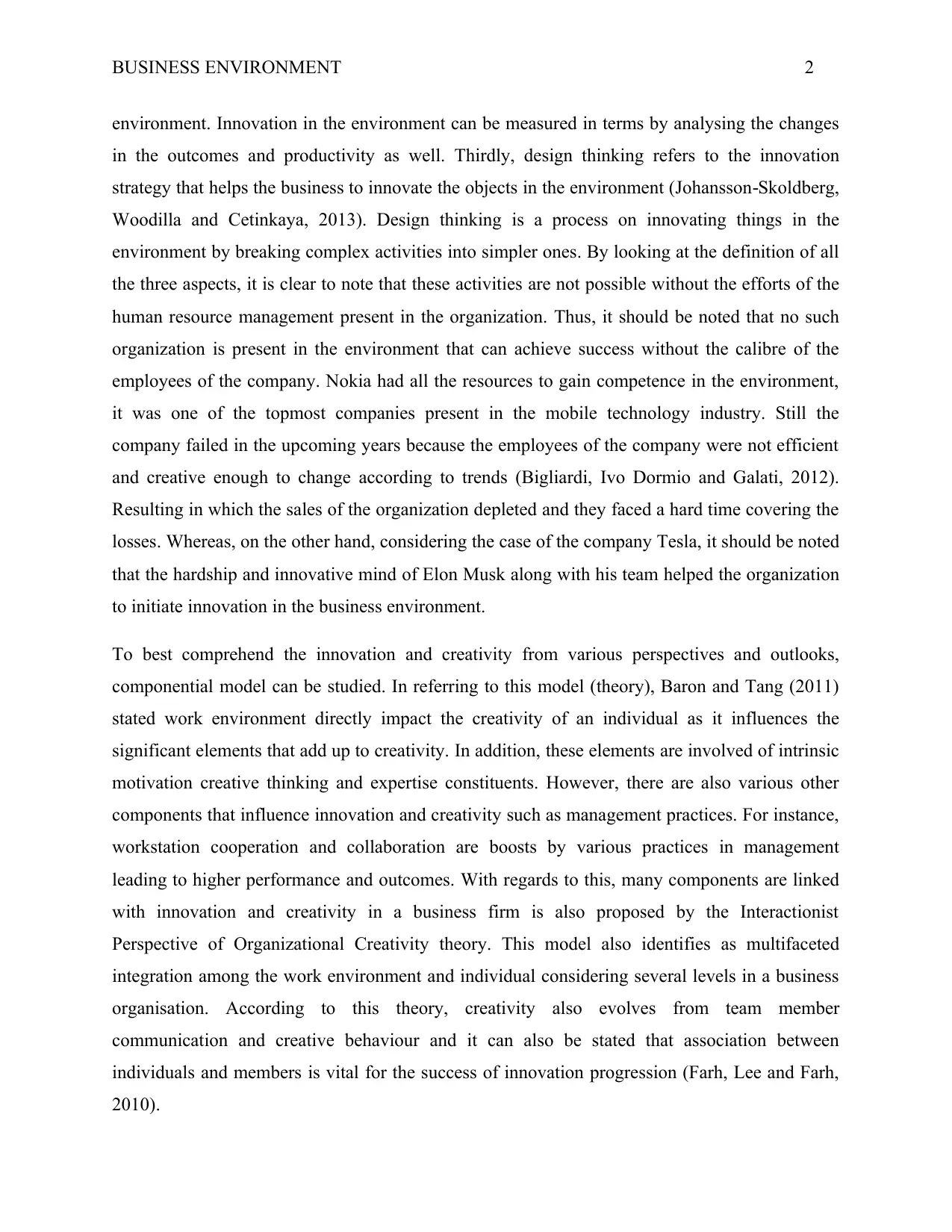
BUSINESS ENVIRONMENT 2
environment. Innovation in the environment can be measured in terms by analysing the changes
in the outcomes and productivity as well. Thirdly, design thinking refers to the innovation
strategy that helps the business to innovate the objects in the environment (Johansson Skoldberg,‐
Woodilla and Cetinkaya, 2013). Design thinking is a process on innovating things in the
environment by breaking complex activities into simpler ones. By looking at the definition of all
the three aspects, it is clear to note that these activities are not possible without the efforts of the
human resource management present in the organization. Thus, it should be noted that no such
organization is present in the environment that can achieve success without the calibre of the
employees of the company. Nokia had all the resources to gain competence in the environment,
it was one of the topmost companies present in the mobile technology industry. Still the
company failed in the upcoming years because the employees of the company were not efficient
and creative enough to change according to trends (Bigliardi, Ivo Dormio and Galati, 2012).
Resulting in which the sales of the organization depleted and they faced a hard time covering the
losses. Whereas, on the other hand, considering the case of the company Tesla, it should be noted
that the hardship and innovative mind of Elon Musk along with his team helped the organization
to initiate innovation in the business environment.
To best comprehend the innovation and creativity from various perspectives and outlooks,
componential model can be studied. In referring to this model (theory), Baron and Tang (2011)
stated work environment directly impact the creativity of an individual as it influences the
significant elements that add up to creativity. In addition, these elements are involved of intrinsic
motivation creative thinking and expertise constituents. However, there are also various other
components that influence innovation and creativity such as management practices. For instance,
workstation cooperation and collaboration are boosts by various practices in management
leading to higher performance and outcomes. With regards to this, many components are linked
with innovation and creativity in a business firm is also proposed by the Interactionist
Perspective of Organizational Creativity theory. This model also identifies as multifaceted
integration among the work environment and individual considering several levels in a business
organisation. According to this theory, creativity also evolves from team member
communication and creative behaviour and it can also be stated that association between
individuals and members is vital for the success of innovation progression (Farh, Lee and Farh,
2010).
environment. Innovation in the environment can be measured in terms by analysing the changes
in the outcomes and productivity as well. Thirdly, design thinking refers to the innovation
strategy that helps the business to innovate the objects in the environment (Johansson Skoldberg,‐
Woodilla and Cetinkaya, 2013). Design thinking is a process on innovating things in the
environment by breaking complex activities into simpler ones. By looking at the definition of all
the three aspects, it is clear to note that these activities are not possible without the efforts of the
human resource management present in the organization. Thus, it should be noted that no such
organization is present in the environment that can achieve success without the calibre of the
employees of the company. Nokia had all the resources to gain competence in the environment,
it was one of the topmost companies present in the mobile technology industry. Still the
company failed in the upcoming years because the employees of the company were not efficient
and creative enough to change according to trends (Bigliardi, Ivo Dormio and Galati, 2012).
Resulting in which the sales of the organization depleted and they faced a hard time covering the
losses. Whereas, on the other hand, considering the case of the company Tesla, it should be noted
that the hardship and innovative mind of Elon Musk along with his team helped the organization
to initiate innovation in the business environment.
To best comprehend the innovation and creativity from various perspectives and outlooks,
componential model can be studied. In referring to this model (theory), Baron and Tang (2011)
stated work environment directly impact the creativity of an individual as it influences the
significant elements that add up to creativity. In addition, these elements are involved of intrinsic
motivation creative thinking and expertise constituents. However, there are also various other
components that influence innovation and creativity such as management practices. For instance,
workstation cooperation and collaboration are boosts by various practices in management
leading to higher performance and outcomes. With regards to this, many components are linked
with innovation and creativity in a business firm is also proposed by the Interactionist
Perspective of Organizational Creativity theory. This model also identifies as multifaceted
integration among the work environment and individual considering several levels in a business
organisation. According to this theory, creativity also evolves from team member
communication and creative behaviour and it can also be stated that association between
individuals and members is vital for the success of innovation progression (Farh, Lee and Farh,
2010).
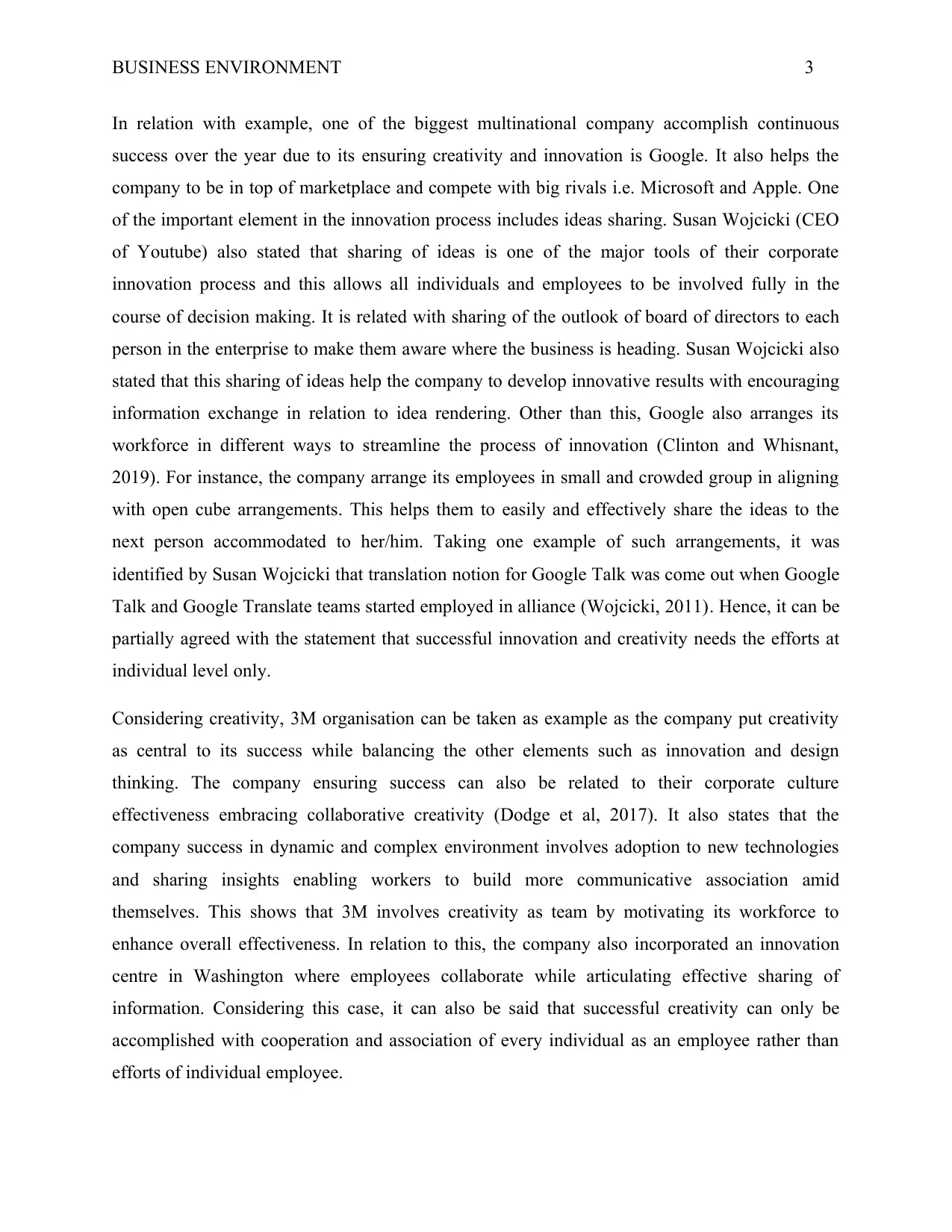
BUSINESS ENVIRONMENT 3
In relation with example, one of the biggest multinational company accomplish continuous
success over the year due to its ensuring creativity and innovation is Google. It also helps the
company to be in top of marketplace and compete with big rivals i.e. Microsoft and Apple. One
of the important element in the innovation process includes ideas sharing. Susan Wojcicki (CEO
of Youtube) also stated that sharing of ideas is one of the major tools of their corporate
innovation process and this allows all individuals and employees to be involved fully in the
course of decision making. It is related with sharing of the outlook of board of directors to each
person in the enterprise to make them aware where the business is heading. Susan Wojcicki also
stated that this sharing of ideas help the company to develop innovative results with encouraging
information exchange in relation to idea rendering. Other than this, Google also arranges its
workforce in different ways to streamline the process of innovation (Clinton and Whisnant,
2019). For instance, the company arrange its employees in small and crowded group in aligning
with open cube arrangements. This helps them to easily and effectively share the ideas to the
next person accommodated to her/him. Taking one example of such arrangements, it was
identified by Susan Wojcicki that translation notion for Google Talk was come out when Google
Talk and Google Translate teams started employed in alliance (Wojcicki, 2011). Hence, it can be
partially agreed with the statement that successful innovation and creativity needs the efforts at
individual level only.
Considering creativity, 3M organisation can be taken as example as the company put creativity
as central to its success while balancing the other elements such as innovation and design
thinking. The company ensuring success can also be related to their corporate culture
effectiveness embracing collaborative creativity (Dodge et al, 2017). It also states that the
company success in dynamic and complex environment involves adoption to new technologies
and sharing insights enabling workers to build more communicative association amid
themselves. This shows that 3M involves creativity as team by motivating its workforce to
enhance overall effectiveness. In relation to this, the company also incorporated an innovation
centre in Washington where employees collaborate while articulating effective sharing of
information. Considering this case, it can also be said that successful creativity can only be
accomplished with cooperation and association of every individual as an employee rather than
efforts of individual employee.
In relation with example, one of the biggest multinational company accomplish continuous
success over the year due to its ensuring creativity and innovation is Google. It also helps the
company to be in top of marketplace and compete with big rivals i.e. Microsoft and Apple. One
of the important element in the innovation process includes ideas sharing. Susan Wojcicki (CEO
of Youtube) also stated that sharing of ideas is one of the major tools of their corporate
innovation process and this allows all individuals and employees to be involved fully in the
course of decision making. It is related with sharing of the outlook of board of directors to each
person in the enterprise to make them aware where the business is heading. Susan Wojcicki also
stated that this sharing of ideas help the company to develop innovative results with encouraging
information exchange in relation to idea rendering. Other than this, Google also arranges its
workforce in different ways to streamline the process of innovation (Clinton and Whisnant,
2019). For instance, the company arrange its employees in small and crowded group in aligning
with open cube arrangements. This helps them to easily and effectively share the ideas to the
next person accommodated to her/him. Taking one example of such arrangements, it was
identified by Susan Wojcicki that translation notion for Google Talk was come out when Google
Talk and Google Translate teams started employed in alliance (Wojcicki, 2011). Hence, it can be
partially agreed with the statement that successful innovation and creativity needs the efforts at
individual level only.
Considering creativity, 3M organisation can be taken as example as the company put creativity
as central to its success while balancing the other elements such as innovation and design
thinking. The company ensuring success can also be related to their corporate culture
effectiveness embracing collaborative creativity (Dodge et al, 2017). It also states that the
company success in dynamic and complex environment involves adoption to new technologies
and sharing insights enabling workers to build more communicative association amid
themselves. This shows that 3M involves creativity as team by motivating its workforce to
enhance overall effectiveness. In relation to this, the company also incorporated an innovation
centre in Washington where employees collaborate while articulating effective sharing of
information. Considering this case, it can also be said that successful creativity can only be
accomplished with cooperation and association of every individual as an employee rather than
efforts of individual employee.
Secure Best Marks with AI Grader
Need help grading? Try our AI Grader for instant feedback on your assignments.
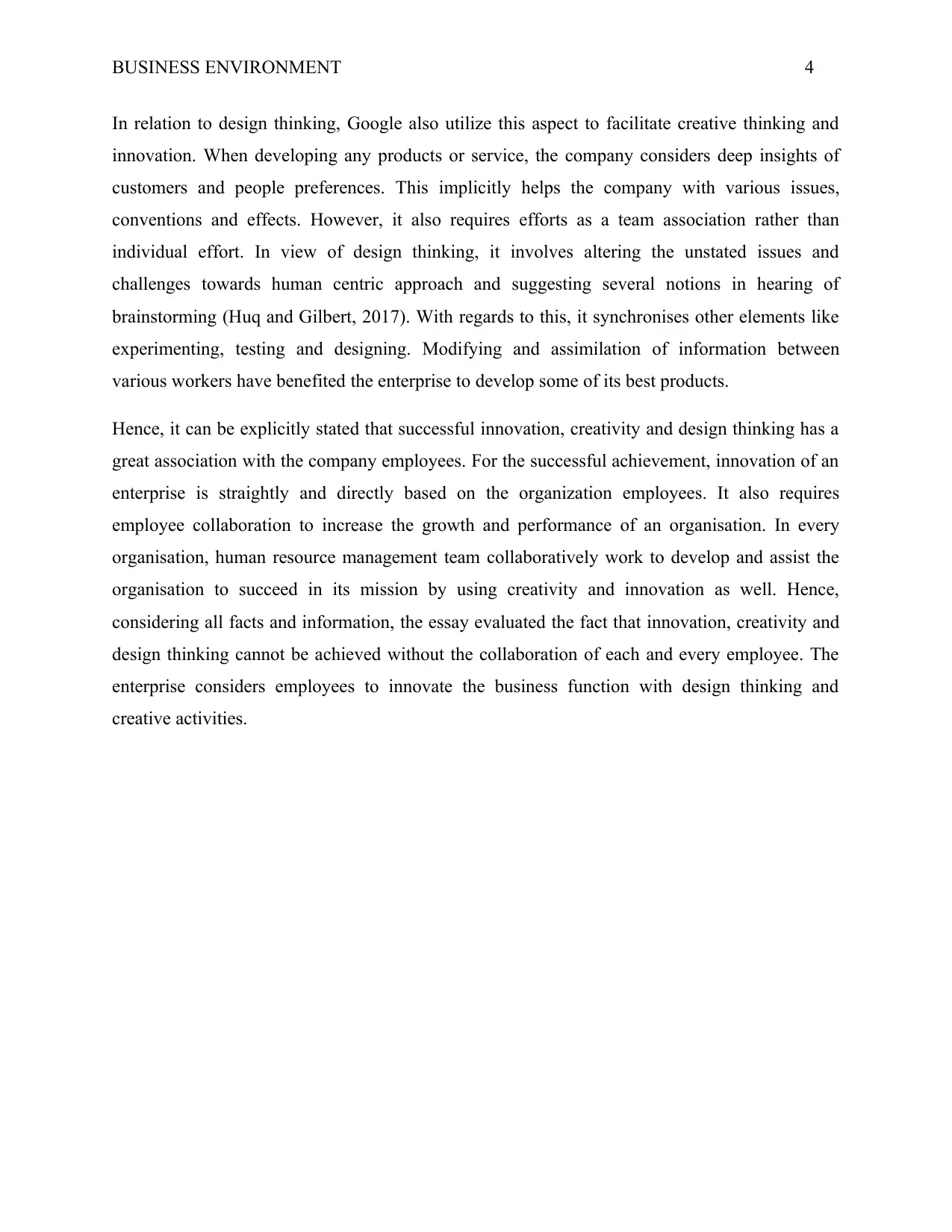
BUSINESS ENVIRONMENT 4
In relation to design thinking, Google also utilize this aspect to facilitate creative thinking and
innovation. When developing any products or service, the company considers deep insights of
customers and people preferences. This implicitly helps the company with various issues,
conventions and effects. However, it also requires efforts as a team association rather than
individual effort. In view of design thinking, it involves altering the unstated issues and
challenges towards human centric approach and suggesting several notions in hearing of
brainstorming (Huq and Gilbert, 2017). With regards to this, it synchronises other elements like
experimenting, testing and designing. Modifying and assimilation of information between
various workers have benefited the enterprise to develop some of its best products.
Hence, it can be explicitly stated that successful innovation, creativity and design thinking has a
great association with the company employees. For the successful achievement, innovation of an
enterprise is straightly and directly based on the organization employees. It also requires
employee collaboration to increase the growth and performance of an organisation. In every
organisation, human resource management team collaboratively work to develop and assist the
organisation to succeed in its mission by using creativity and innovation as well. Hence,
considering all facts and information, the essay evaluated the fact that innovation, creativity and
design thinking cannot be achieved without the collaboration of each and every employee. The
enterprise considers employees to innovate the business function with design thinking and
creative activities.
In relation to design thinking, Google also utilize this aspect to facilitate creative thinking and
innovation. When developing any products or service, the company considers deep insights of
customers and people preferences. This implicitly helps the company with various issues,
conventions and effects. However, it also requires efforts as a team association rather than
individual effort. In view of design thinking, it involves altering the unstated issues and
challenges towards human centric approach and suggesting several notions in hearing of
brainstorming (Huq and Gilbert, 2017). With regards to this, it synchronises other elements like
experimenting, testing and designing. Modifying and assimilation of information between
various workers have benefited the enterprise to develop some of its best products.
Hence, it can be explicitly stated that successful innovation, creativity and design thinking has a
great association with the company employees. For the successful achievement, innovation of an
enterprise is straightly and directly based on the organization employees. It also requires
employee collaboration to increase the growth and performance of an organisation. In every
organisation, human resource management team collaboratively work to develop and assist the
organisation to succeed in its mission by using creativity and innovation as well. Hence,
considering all facts and information, the essay evaluated the fact that innovation, creativity and
design thinking cannot be achieved without the collaboration of each and every employee. The
enterprise considers employees to innovate the business function with design thinking and
creative activities.
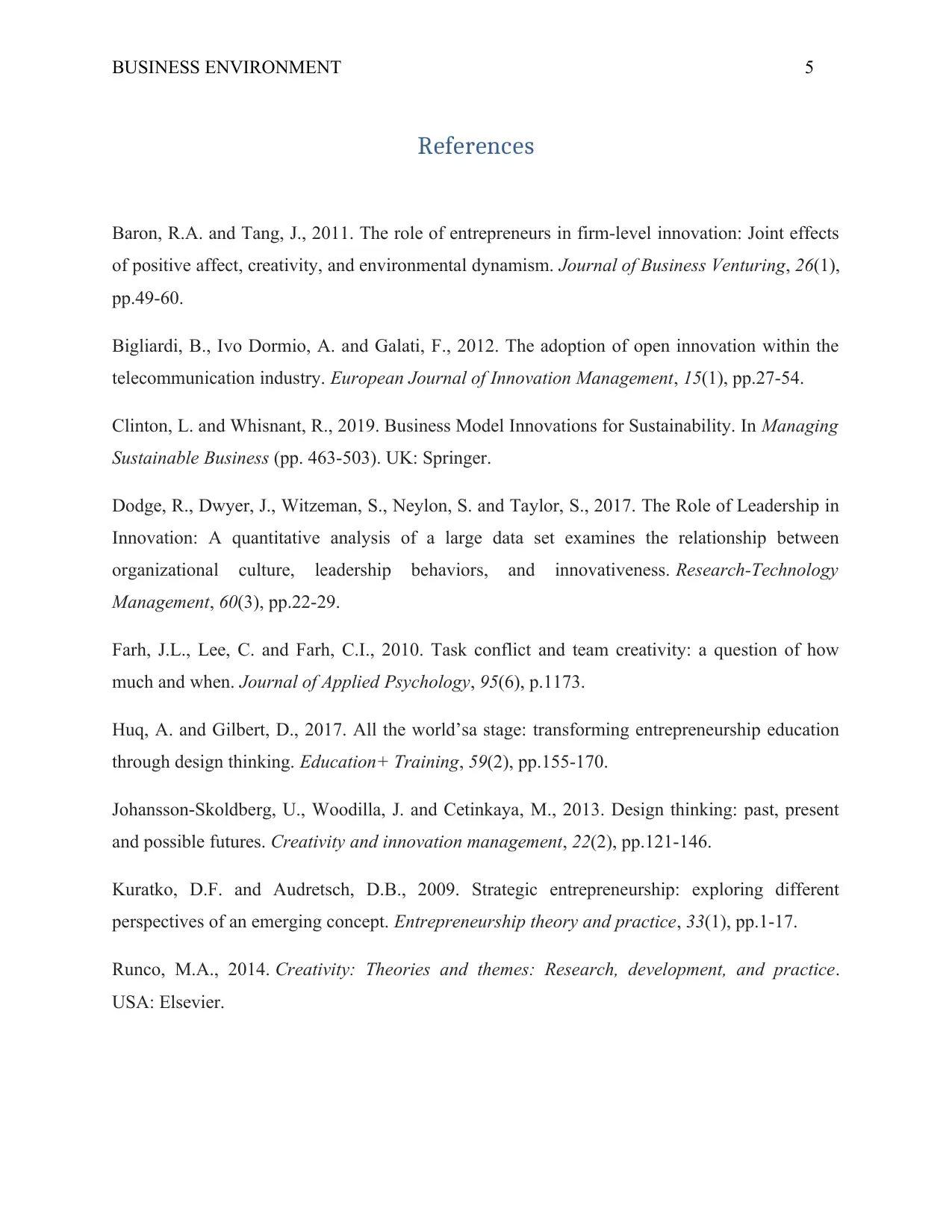
BUSINESS ENVIRONMENT 5
References
Baron, R.A. and Tang, J., 2011. The role of entrepreneurs in firm-level innovation: Joint effects
of positive affect, creativity, and environmental dynamism. Journal of Business Venturing, 26(1),
pp.49-60.
Bigliardi, B., Ivo Dormio, A. and Galati, F., 2012. The adoption of open innovation within the
telecommunication industry. European Journal of Innovation Management, 15(1), pp.27-54.
Clinton, L. and Whisnant, R., 2019. Business Model Innovations for Sustainability. In Managing
Sustainable Business (pp. 463-503). UK: Springer.
Dodge, R., Dwyer, J., Witzeman, S., Neylon, S. and Taylor, S., 2017. The Role of Leadership in
Innovation: A quantitative analysis of a large data set examines the relationship between
organizational culture, leadership behaviors, and innovativeness. Research-Technology
Management, 60(3), pp.22-29.
Farh, J.L., Lee, C. and Farh, C.I., 2010. Task conflict and team creativity: a question of how
much and when. Journal of Applied Psychology, 95(6), p.1173.
Huq, A. and Gilbert, D., 2017. All the world’sa stage: transforming entrepreneurship education
through design thinking. Education+ Training, 59(2), pp.155-170.
Johansson Skoldberg, U., Woodilla, J. and Cetinkaya, M., 2013. Design thinking: past, present‐
and possible futures. Creativity and innovation management, 22(2), pp.121-146.
Kuratko, D.F. and Audretsch, D.B., 2009. Strategic entrepreneurship: exploring different
perspectives of an emerging concept. Entrepreneurship theory and practice, 33(1), pp.1-17.
Runco, M.A., 2014. Creativity: Theories and themes: Research, development, and practice.
USA: Elsevier.
References
Baron, R.A. and Tang, J., 2011. The role of entrepreneurs in firm-level innovation: Joint effects
of positive affect, creativity, and environmental dynamism. Journal of Business Venturing, 26(1),
pp.49-60.
Bigliardi, B., Ivo Dormio, A. and Galati, F., 2012. The adoption of open innovation within the
telecommunication industry. European Journal of Innovation Management, 15(1), pp.27-54.
Clinton, L. and Whisnant, R., 2019. Business Model Innovations for Sustainability. In Managing
Sustainable Business (pp. 463-503). UK: Springer.
Dodge, R., Dwyer, J., Witzeman, S., Neylon, S. and Taylor, S., 2017. The Role of Leadership in
Innovation: A quantitative analysis of a large data set examines the relationship between
organizational culture, leadership behaviors, and innovativeness. Research-Technology
Management, 60(3), pp.22-29.
Farh, J.L., Lee, C. and Farh, C.I., 2010. Task conflict and team creativity: a question of how
much and when. Journal of Applied Psychology, 95(6), p.1173.
Huq, A. and Gilbert, D., 2017. All the world’sa stage: transforming entrepreneurship education
through design thinking. Education+ Training, 59(2), pp.155-170.
Johansson Skoldberg, U., Woodilla, J. and Cetinkaya, M., 2013. Design thinking: past, present‐
and possible futures. Creativity and innovation management, 22(2), pp.121-146.
Kuratko, D.F. and Audretsch, D.B., 2009. Strategic entrepreneurship: exploring different
perspectives of an emerging concept. Entrepreneurship theory and practice, 33(1), pp.1-17.
Runco, M.A., 2014. Creativity: Theories and themes: Research, development, and practice.
USA: Elsevier.
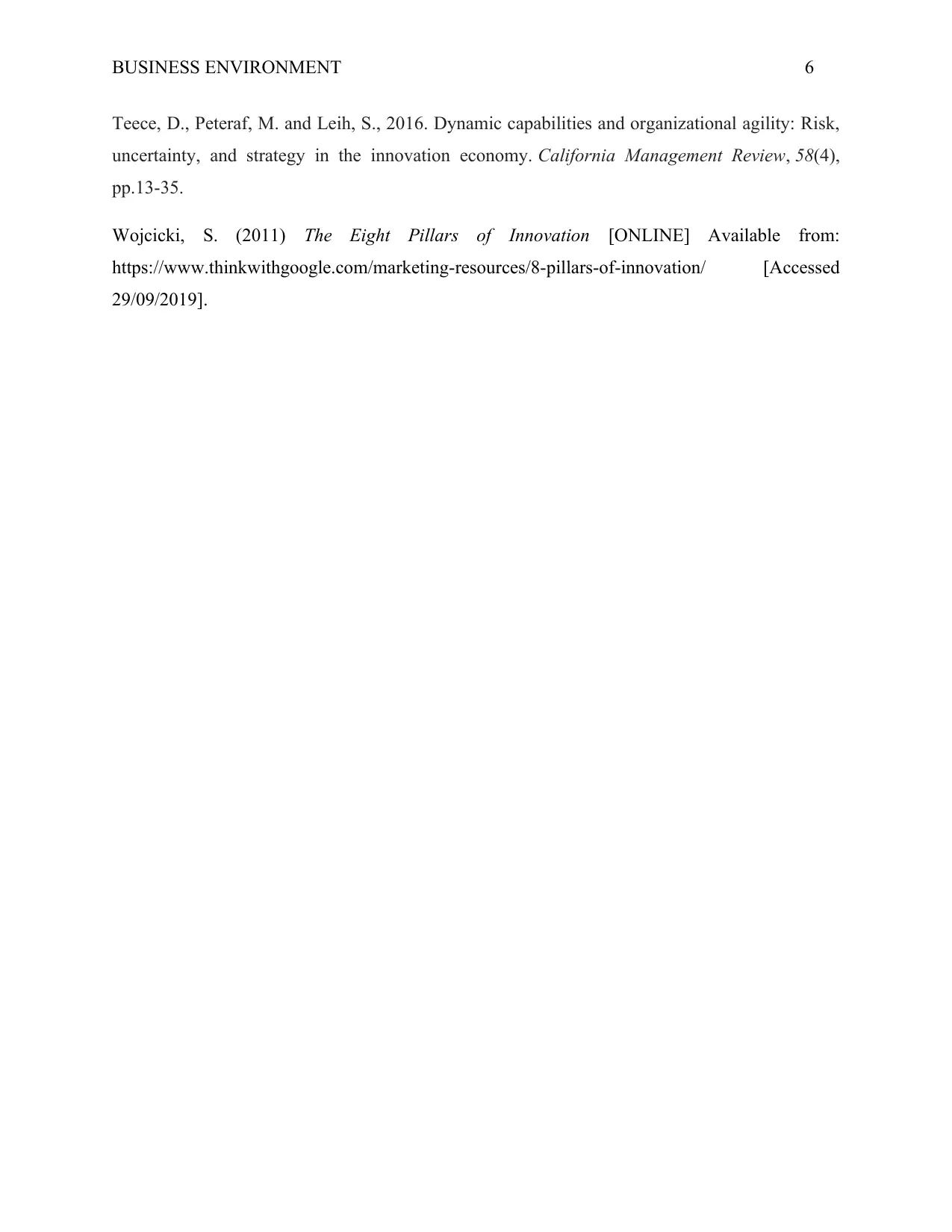
BUSINESS ENVIRONMENT 6
Teece, D., Peteraf, M. and Leih, S., 2016. Dynamic capabilities and organizational agility: Risk,
uncertainty, and strategy in the innovation economy. California Management Review, 58(4),
pp.13-35.
Wojcicki, S. (2011) The Eight Pillars of Innovation [ONLINE] Available from:
https://www.thinkwithgoogle.com/marketing-resources/8-pillars-of-innovation/ [Accessed
29/09/2019].
Teece, D., Peteraf, M. and Leih, S., 2016. Dynamic capabilities and organizational agility: Risk,
uncertainty, and strategy in the innovation economy. California Management Review, 58(4),
pp.13-35.
Wojcicki, S. (2011) The Eight Pillars of Innovation [ONLINE] Available from:
https://www.thinkwithgoogle.com/marketing-resources/8-pillars-of-innovation/ [Accessed
29/09/2019].
1 out of 7
Related Documents
Your All-in-One AI-Powered Toolkit for Academic Success.
+13062052269
info@desklib.com
Available 24*7 on WhatsApp / Email
![[object Object]](/_next/static/media/star-bottom.7253800d.svg)
Unlock your academic potential
© 2024 | Zucol Services PVT LTD | All rights reserved.





